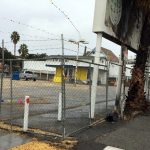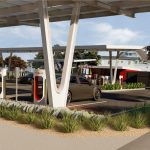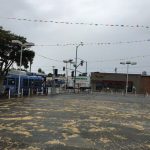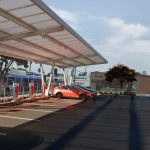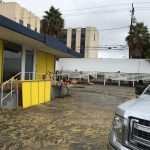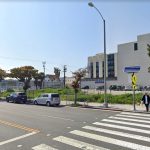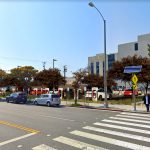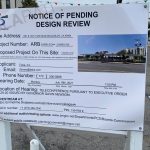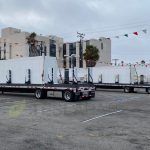

News
Tesla’s Santa Monica Supercharger imagined in new renders, but where’s the 50’s diner?
Tesla’s massive Supercharger facility in Santa Monica, California, has been visualized in new renders, giving plenty of indication of what is to come to what is arguably the automaker’s most highly-anticipated charging facility to date. While the new graphics give a look into the future with V3 charging stalls giving Teslas additional range, the photos also show the restroom facility that will be available to those who will utilize the 62-stall facility in the heart of Los Angeles’ beach town, the rumors of a restaurant and movie screen seem lofty, especially as real estate for the lofty design seems to be minimal, and the new renders didn’t include any visualizations of the planned 50’s diner.
Tesla’s 62-stall V3 Supercharger in Santa Monica
Since early 2021, Teslarati has been closely following the situation in Santa Monica. Initially, there was a lot of speculation of what was to come after a 2018 announcement from Elon Musk, CEO of Tesla, who said that a drive-in movie theater with a roller rink was coming to Santa Monica, giving Tesla owners one of the most unique Supercharging experiences yet. The project finally took off after Tesla gained preliminary approval to build 62 of its fastest EV chargers across two vacant lots, located at 1401 and 1421-1425 Santa Monica Boulevard.
The lot was at one time home to Steve Taub Porsche-Audi, but this dealership closed down. For a couple of years, the lots were used to sell seasonal items like Christmas trees and Pumpkins for Halloween. That is until Tesla submitted their 2018 plans for a restaurant and drive-in movie theater. However, it would not be until 2021 that Tesla finally started making some progress with the site.
Elon Musk confirms major Tesla Santa Monica Supercharger: 50’s-style diner, drive-in movie clips
After preliminary plans were approved and put into place, Tesla had a full-scale blueprint of what the facility would look like. Ultimately, the 62-stalls would be complemented with a restroom facility, Cybertruck-designed spots, and solar canopies that would provide the V3 chargers with power. The additional energy would be stored in a Tesla Megapack, just like many of its other large-scale commercial projects that require energy storage.
The project took a short-term detour as Santa Monica City Council members decided that the site could be more beneficially utilized as housing. This was a short-lived derailment of the Tesla project, and Santa Monica’s council members chose to let Tesla have their project.
The new renders: 1401 Santa Monica Boulevard
The new renders obtained by Teslarati via the GPD Group, the developer responsible for the project, show plenty of before and after angles of what will eventually be known as the Santa Monica Supercharger.
- Credit: GPD Group
- What 1401 Santa Monica Blvd. will look like after Tesla finishes the Santa Monica Supercharger project. (Credit: GPD Group)
- Credit: GPD Group
- Credit: GPD Group
- Credit: GPD Group
- Credit: GPD Group
- Credit: GPD Group
- Tesla’s full-service bathroom accomodations for 1401 Santa Monica Blvd. (Credit: GPD Group)
The renders above are for the first lot, located at 1401 Santa Monica Boulevard. This lot will be home to 36 of the 62 V3 chargers. Along with the chargers, the indoor restroom facility will be located on this lot. The GPD Group renders show that the company will transition an already-standing building on the lot into the restroom building. The solar canopies will also be installed on this lot, as it is the location of a majority of the Supercharging stalls.
The new renders: 1421-1425 Santa Monica Boulevard
The remaining 26 V3 Superchargers will be located on the lot at 1421-1425 Santa Monica Boulevard. The spaces in this lot are of varying widths and lengths, hinting toward Cybertruck-specific charging stalls as the automaker prepares for production of the all-electric pickup later this year.
- Credit: GPD Group
- Credit: GPD Group
Where’s the restaurant?
Now, unfortunately, there are no renders, images, or even hints that Tesla’s 50’s-style diner will even be at this location. Based on the images and previously published blueprints of the plans for the 62-stall Supercharger facility on Santa Monica Blvd., there isn’t much space for one, either. However, there are plenty of indications that Tesla has not included this in any plans, blueprints, or images as of yet. In fact, there is a strong possibility that the company will be submitting these soon, as there is a six-month revision period that Tesla can utilize that will expire in early September, according to documents.
Tesla is officially planning to enter the restaurant business
The documents that the Santa Monica City Council has released seem to suggest that there will be a restaurant on the premises, however. According to the subheading “Construction Plan Requirements,” Tesla will be required to oblige by sanitation and food safety requirements if it ultimately decides to build a restaurant at the facility, of course. It looks like it will be a relatively intimate space, as the documents state that there will likely be less than 50 seats on the interior of the restaurant. This makes sense, however, as there are only 62 stalls, to begin with, drivers and passengers will likely want to eat their food in their own car, and the planned 100 greatest movie clips of all-time that Musk has hinted toward will likely be projected on an outdoor screen or displayed through each vehicle’s individual center screen.
What’s going on at the site as of July 13?
Currently, several things are going on at the two vacant lots. First, the project will be subjected to a “Pending Design Review” next Monday, July 19th, at 7 PM PST. There are opportunities for members of the public to livestream or dial into the event. It is unknown what the call will actually provide, but it appears that the final steps could be finalized before construction can begin.
Additionally, Tesla has been transporting prefabricated Superchargers to the lots. Based on images sent in by a Teslarati reader, we can see that Tesla is bringing these prefab Superchargers to the area for what is likely to be temporary measures.
- Credit: Brain Deming
- Credit: Brain Deming
- Credit: Brain Deming
Tesla previously used prefabricated Superchargers at a site in Beaver, Utah. However, these Superchargers were not permanent, and they were utilized to likely charge vehicles that had arrived on site for unknown reasons. As you can see, they are identical to the Superchargers seen here.
For now, the Santa Monica Supercharger project remains in the hands of the City Council Members. However, next week, there should be more answers, as the call will likely allow Tesla to move forward with this highly-anticipated project.

Elon Musk
Elon Musk and Tesla AI Director share insights after empty driver seat Robotaxi rides
The executives’ unoccupied tests hint at the rapid progress of Tesla’s unsupervised Robotaxi efforts.

Tesla CEO Elon Musk and AI Director Ashok Elluswamy celebrated Christmas Eve by sharing personal experiences with Robotaxi vehicles that had no safety monitor or occupant in the driver’s seat. Musk described the system’s “perfect driving” around Austin, while Elluswamy posted video from the back seat, calling it “an amazing experience.”
The executives’ unoccupied tests hint at the rapid progress of Tesla’s unsupervised Robotaxi efforts.
Elon and Ashok’s firsthand Robotaxi insights
Prior to Musk and the Tesla AI Director’s posts, sightings of unmanned Teslas navigating public roads were widely shared on social media. One such vehicle was spotted in Austin, Texas, which Elon Musk acknowleged by stating that “Testing is underway with no occupants in the car.”
Based on his Christmas Eve post, Musk seemed to have tested an unmanned Tesla himself. “A Tesla with no safety monitor in the car and me sitting in the passenger seat took me all around Austin on Sunday with perfect driving,” Musk wrote in his post.
Elluswamy responded with a 2-minute video showing himself in the rear of an unmanned Tesla. The video featured the vehicle’s empty front seats, as well as its smooth handling through real-world traffic. He captioned his video with the words, “It’s an amazing experience!”
Towards Unsupervised operations
During an xAI Hackathon earlier this month, Elon Musk mentioned that Tesla owed be removing Safety Monitors from its Robotaxis in Austin in just three weeks. “Unsupervised is pretty much solved at this point. So there will be Tesla Robotaxis operating in Austin with no one in them. Not even anyone in the passenger seat in about three weeks,” he said. Musk echoed similar estimates at the 2025 Annual Shareholder Meeting and the Q3 2025 earnings call.
Considering the insights that were posted Musk and Elluswamy, it does appear that Tesla is working hard towards operating its Robotaxis with no safety monitors. This is quite impressive considering that the service was launched just earlier this year.
Elon Musk
Starlink passes 9 million active customers just weeks after hitting 8 million
The milestone highlights the accelerating growth of Starlink, which has now been adding over 20,000 new users per day.

SpaceX’s Starlink satellite internet service has continued its rapid global expansion, surpassing 9 million active customers just weeks after crossing the 8 million mark.
The milestone highlights the accelerating growth of Starlink, which has now been adding over 20,000 new users per day.
9 million customers
In a post on X, SpaceX stated that Starlink now serves over 9 million active users across 155 countries, territories, and markets. The company reached 8 million customers in early November, meaning it added roughly 1 million subscribers in under seven weeks, or about 21,275 new users on average per day.
“Starlink is connecting more than 9M active customers with high-speed internet across 155 countries, territories, and many other markets,” Starlink wrote in a post on its official X account. SpaceX President Gwynne Shotwell also celebrated the milestone on X. “A huge thank you to all of our customers and congrats to the Starlink team for such an incredible product,” she wrote.
That growth rate reflects both rising demand for broadband in underserved regions and Starlink’s expanding satellite constellation, which now includes more than 9,000 low-Earth-orbit satellites designed to deliver high-speed, low-latency internet worldwide.
Starlink’s momentum
Starlink’s momentum has been building up. SpaceX reported 4.6 million Starlink customers in December 2024, followed by 7 million by August 2025, and 8 million customers in November. Independent data also suggests Starlink usage is rising sharply, with Cloudflare reporting that global web traffic from Starlink users more than doubled in 2025, as noted in an Insider report.
Starlink’s momentum is increasingly tied to SpaceX’s broader financial outlook. Elon Musk has said the satellite network is “by far” the company’s largest revenue driver, and reports suggest SpaceX may be positioning itself for an initial public offering as soon as next year, with valuations estimated as high as $1.5 trillion. Musk has also suggested in the past that Starlink could have its own IPO in the future.
News
NVIDIA Director of Robotics: Tesla FSD v14 is the first AI to pass the “Physical Turing Test”
After testing FSD v14, Fan stated that his experience with FSD felt magical at first, but it soon started to feel like a routine.

NVIDIA Director of Robotics Jim Fan has praised Tesla’s Full Self-Driving (Supervised) v14 as the first AI to pass what he described as a “Physical Turing Test.”
After testing FSD v14, Fan stated that his experience with FSD felt magical at first, but it soon started to feel like a routine. And just like smartphones today, removing it now would “actively hurt.”
Jim Fan’s hands-on FSD v14 impressions
Fan, a leading researcher in embodied AI who is currently solving Physical AI at NVIDIA and spearheading the company’s Project GR00T initiative, noted that he actually was late to the Tesla game. He was, however, one of the first to try out FSD v14.
“I was very late to own a Tesla but among the earliest to try out FSD v14. It’s perhaps the first time I experience an AI that passes the Physical Turing Test: after a long day at work, you press a button, lay back, and couldn’t tell if a neural net or a human drove you home,” Fan wrote in a post on X.
Fan added: “Despite knowing exactly how robot learning works, I still find it magical watching the steering wheel turn by itself. First it feels surreal, next it becomes routine. Then, like the smartphone, taking it away actively hurts. This is how humanity gets rewired and glued to god-like technologies.”
The Physical Turing Test
The original Turing Test was conceived by Alan Turing in 1950, and it was aimed at determining if a machine could exhibit behavior that is equivalent to or indistinguishable from a human. By focusing on text-based conversations, the original Turing Test set a high bar for natural language processing and machine learning.
This test has been passed by today’s large language models. However, the capability to converse in a humanlike manner is a completely different challenge from performing real-world problem-solving or physical interactions. Thus, Fan introduced the Physical Turing Test, which challenges AI systems to demonstrate intelligence through physical actions.
Based on Fan’s comments, Tesla has demonstrated these intelligent physical actions with FSD v14. Elon Musk agreed with the NVIDIA executive, stating in a post on X that with FSD v14, “you can sense the sentience maturing.” Musk also praised Tesla AI, calling it the best “real-world AI” today.


